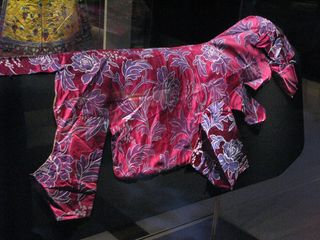Posh Dog Outfit from China's 'Forbidden City' Revealed

While President Barack Obama has Bo and Sunny, and President George W. Bush had Barney and Miss Beazley, a newly published tale of a dog that lived in China's Forbidden City more than a century ago reveals this pup's lifestyle easily outdid that of any presidential pooch.
The royal dog named Big Luck (in translation) had a silk outfit, specially tailored, that covered the dog from snout to tail, the researchers revealed for the first time in a book. Although the dog's breed is unknown, and the sex is uncertain, it appears to have been about 3 feet (1 meter) long and the outfit was decorated with images of peonies. It even has the dog's name inscribed on the lining. It was created during the reign of the Guangxu emperor (A.D. 1875-1908).
"This is absolutely (a) surprise," said Chen Shen, a curator at Toronto's Royal Ontario Museum, in an interview with Live Science. The outfit is being featured in a Forbidden City exhibition that opened to the public on Saturday, March 8. [See Stunning Photos of Treasures from China's Forbidden City]
Shen's team learned of the dog's outfit during a trip to China's Palace Museum, where his team worked with the museum's staff to choose artifacts for the exhibition.
The Forbidden City is a palace complex containing about 980 buildings, and was home to China's emperors from 1420 to 1911. As its name suggests, the complex was off-limits to the public and could only be accessed by the emperor, his immediate family, the royal women and thousands of castrated male servants known as eunuchs.
Pampered pooch
To say that Big Luck lived the high life is an understatement. "In the Forbidden City, royal dogs received royal treatment," Shen and co-author Wen-Chien Cheng, who is also a curator at the Royal Ontario Museum, write in their book "The Forbidden City: Inside the Court of China' s Emperors" (Royal Ontario Museum Press, 2014), where a description the outfit was published.
Sign up for the Live Science daily newsletter now
Get the world’s most fascinating discoveries delivered straight to your inbox.
"They reportedly lived in pavilions with marble floors, sleeping on silk cushions, tended by specialized eunuchs who worked for the Dog Raising Office," they write.
"Court ladies in particular entertained themselves by walking, playing with, and dressing up their dogs," the researchers write. "Every year, dozens of luxurious dog outfits were commissioned, the pet's name carefully recorded on the lining."
However, the emperor himself didn't necessarily own each dog in the same way that Presidents Obama or Bush owned theirs. "There's no records specifically saying what dogs belong to the emperor," Shen said.
Dog days
Unfortunately for the dogs, the days of living the high life were approaching their end around the time that Big Luck lived. The Qing Dynasty was falling into decline, the Qing military was becoming weaker relative to the western powers, and China was experiencing a great deal of civil strife.
In 1900, after the Boxer Rebellion was crushed, a foreign army occupied Beijing and looted the Forbidden City. In 1911 the last emperor of China, a child named Puyi, fled the Forbidden City and was forced to give up the throne, bringing an end to the royal family and their canine companions.
However, the emperors left a canine legacy that is still with us today. "Many of the world's most popular lapdogs, such as the Pekinese jinghabagou and pug, originated in China," the researchers write in their book.
Shen said that another outfit belonging to a smaller dog will also be added to the exhibition.
Follow us @livescience, Facebook & Google+. Original article on Live Science.

Owen Jarus is a regular contributor to Live Science who writes about archaeology and humans' past. He has also written for The Independent (UK), The Canadian Press (CP) and The Associated Press (AP), among others. Owen has a bachelor of arts degree from the University of Toronto and a journalism degree from Ryerson University.
Most Popular

